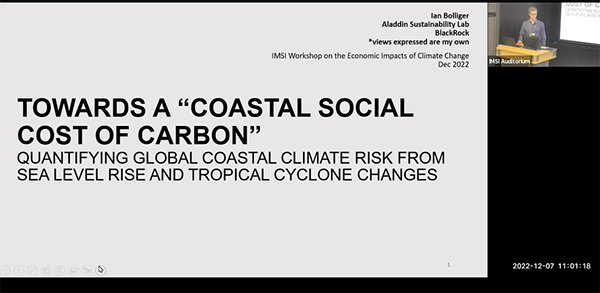Towards a “Coastal Social Cost of Carbon”: Quantifying Global Coastal Climate Risk from Sea Level Rise and Tropical Cyclone Changes
Presenter
December 7, 2022
Event: 37251
Abstract
Tropical cyclones (TCs) are one of the costliest natural disasters, imparting over $50 billion in losses per year in the U.S. alone. Projected intensification of TCs in many ocean basins due to climate change, rising sea levels, and a projected continuation of coastal development will likely all contribute to increasing economic costs in coastal regions over the rest of the 21st century. However, the magnitude, spatial patterns, and dependence on emissions trajectories are all relatively uncertain. In this presentation, I will discuss two complementary models designed to help quantify the global welfare impacts of climate change on coastal communities as realized through both sea level and tropical cyclone changes. The first is a recently completed effort to dynamically model the impacts of sea level change alongside potential adaptation options, combining novel satellite-derived measures of elevation, population, and physical capital, along with sea level projections from the IPCC AR6 report. We simulate impacts and adaptation for >10,000 coastal segments worldwide across multiple emissions scenarios and probabilistic forecasts of sea level change. The second represents ongoing work to simulate the economic impact of tropical cyclone changes. In this study, we construct an open-source, physical-econometric catastrophe model that simulates high-resolution storm surge and wind from >200,000 real and synthetic storm events, probabilistically accounting for local sea level rise. We merge this hazard model with datasets defining population and physical capital both at a global scale and with a high-resolution focus in the continental U.S. Using records of losses from historical events to empirically estimate damage functions for both storm surge and wind losses, we then project future losses under different emissions scenarios. By addressing both sea level rise and tropical cyclone changes, these two models quantify complementary, yet interacting, hazards facing coastal communities. The outputs are in use in multiple contexts, from underpinning physical risk projections for financial assets to contributing to global assessments of the costs of carbon emissions. I will conclude by discussing the manner in which these models will be combined to inform a quantification of the cumulative impacts faced by coastal communities and contribute to bottom-up estimates of the Social Cost of Carbon.
